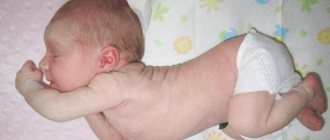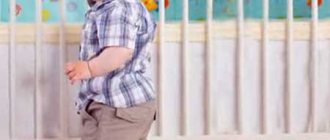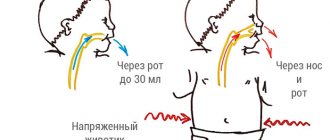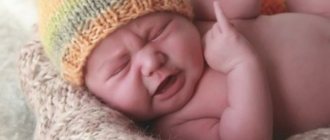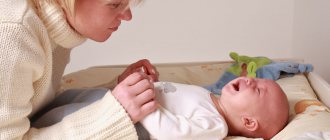Causes
They can be divided into 4 groups:
- Neurological conditions - cerebral palsy, muscular dystrophy and other movement disorders. In these conditions, the baby's calf muscles are stiff, making it difficult or impossible for the baby to place his heel on a hard surface. Therefore, to take a step, the child stands on tiptoes.
- Orthopedic diseases - inflammation of the calcaneus, short calcaneal tendon, clubfoot. In this case, structural changes in the foot make it impossible or painful to lower the heel to the surface.
- Behavioral disorders (autism). If a child begins to walk on his toes, this may be a manifestation of certain symptoms, many of which come with autism.
- Idiopathic tiptoeing.
There are cases when healthy children, without any illnesses, still stubbornly walk on their toes. This is known as idiopathic toe walking and is diagnosed by ruling out all other diseases that cause this type of walking.
Idiopathic tiptoeing involves the child often standing on his toes when walking due to habit. Also, some studies indicate that family members also have this trait.
The most common finding in a child with idiopathic toe walking is tight calf muscles. This makes it even more difficult to lower your heel to the surface and can cause pain when trying to play sports.
Idiopathic walking may be associated with hyper- or hyposensitivity. Some children may not like to touch surfaces with their feet. And then the child stands on his toes to avoid full contact with the foot.
Who should you contact if you are faced with the problem of your child walking on his toes?
Of course, you can make an appointment with a neurologist and orthopedist. In this case, the child will be prescribed a course of massage and gymnastics, which will certainly give positive results, BUT. The massage therapist will not remove the problem that caused the hypertonicity; he works with the consequence of a birth injury. The child may also be recommended to wear orthopedic shoes “forcibly” giving the leg a physiological position when walking. This absolutely cannot be done.
And what is the solution? Fortunately, with the help of osteopathic techniques it is possible to eliminate the root cause of the disease. An osteopathic doctor works with the entire body as a whole, eliminates the incorrect position of the skull bones, works with problems in the cervical spine, thus normalizing proper blood and lymph circulation, innervation, eliminates hypertonicity of the muscles of the lower extremities and the child begins to walk resting on the entire foot.
Dear parents, do not close your eyes to this problem! Disturbances in the nervous system can be expressed not only in the child walking on tiptoes, but subsequently this can affect his neuropsychic development as a whole, and then problems such as attention deficit and poor performance at school may appear. It’s just that when you get older, it’s more difficult to fix the problem.
Unfortunately, some parents may think that the child is thus playing around and do not attach much importance to this problem. This is wrong. Be attentive to your children, good health to you and your loved ones!
When should you see a doctor?
If you are worried, there is no harm in talking to your doctor.
But make an appointment as soon as possible in the following cases:
- if the child walks on his toes most of the time;
- when you feel with your fingers, you feel that the baby has stiff lower leg muscles;
- the child is not coordinated;
- the child constantly stumbles;
- the baby shows signs of delayed development of motor skills;
- the child cannot bear body weight on his leg;
- the baby lost the motor skills he already had.
The doctor will check your child for cerebral palsy and other serious causes of tiptoeing. He may also recommend contacting a speech therapist, since delayed speech development often accompanies this type of walking.
Cerebral palsy
Cerebral palsy is a concept that unites a group of movement disorders that arise as a result of damage to various brain structures in the perinatal period (from the 22nd full week of intrauterine life of the fetus to the 7th day of life of the newborn child). These structures are responsible for controlling motor functions, muscle tone, coordination and posture.
In spastic cerebral palsy, the muscles around the feet are known to become very stiff, which can make walking difficult. Some premature babies may also suffer from bleeding in the brain, which can cause cerebral palsy and lead to problems walking, which promotes walking on their toes.
When a child walks on his toes, what should be done?
Many of the treatment plans that a doctor may prescribe for both idiopathic and causal toe walking involve several areas of intervention.
Exercises at home
Doing exercises at home will be very beneficial for your child. They will allow the calf muscles to stretch and therefore strengthen the front of the legs. Classes will provide additional range of motion and stability to the ankles, allowing the child to step from heel to toe and stand firmly on his feet.
Stretching is the first step. After this, it is important that you and your child participate in activities and exercises that focus on using the pulled muscles.
It is important to engage in activities that are fun and appropriate for the child's age. You can talk to an exercise therapist to learn about fun and innovative exercises you can do at home with your baby.
Massage
Helps children land on their heels when walking. It is better to have a specialist perform foot massage for children with this type of walking. But if this is not possible, parents can perform the required manipulations themselves, after consulting with a children's massage therapist or chiropractor.
Timely massage sessions, in combination with other methods prescribed by the doctor, will perfectly help cope with this problem.
Shoes
The following types of shoes can help limit your child's desire to tiptoe:
- flat shoes. Avoid wearing shoes with wedges or raised heels. Elevating the foot will initially contract the gastrocnemius muscle and result in a toe-toe stance. The ideal option is shoes with flat soles;
- squeaky boots. Some shoes have beepers on the heels. The child gets additional pleasure by lowering his heel to the surface when he steps;
- shoes that catch fire. Some brands of shoes have lights located at the back of the foot. The more the child lowers his heel when walking, the more the light will turn on.
The child walks on his toes
Our child walks on his toes, what should we do? Parents often ask me this question during consultations. After all, it is very important that the baby puts his foot completely on the surface while standing and walking calmly. Not only the toe, but also the heel must be in contact with the support. Support on only one toe and raising the heel when standing is allowed, for example, when a child reaches out to see or reach an object he needs. Having seen or taken out what interested him, he must again stand up, leaning on his full foot. Incomplete support during movement occurs when running, or during an emotional outburst during fast walking. But in a calm state, the baby should walk with his legs fully planted.
Diagnostic tests
If a child walks on his toes, then first it is necessary to determine whether the reliance on his toes is a consequence of the expression of emotions or is it a pathologically increased muscle tone? To do this, perform the following test: place the baby on his back on a table or sofa, straighten his legs and hold them with your hand in the area of the knee joints, pressing them against the surface of the table or sofa. With the other hand, bend your feet until a right angle is formed.
Calf muscle tone test
Test to determine the tone of the calf muscle. Focus on the movements you make in your baby's joints. If, while performing the test, you feel muscle resistance that complicates or limits movement in the ankle joint, then there is increased tone or spasm of the calf muscle. This muscle prevents the heel from sinking to the surface when the child walks or stands. During the test, the child may curl his toes, tense the muscles of the back of the thighs and torso, and experience discomfort. If the child’s increased emotionality is to blame for walking on toes, and the muscle tone is not changed, then during the test you will not feel pronounced muscle resistance to movement. The choice of recommendations for correcting the position of the feet will depend on the reason that led to the child walking on his toes. There are situations when walking on toes is associated with birth trauma and neurological symptoms. In this case, you will need to consult an osteopath or a pediatric neurologist.
It is important!
It is a mistake to think that those babies who walk on their toes will learn to walk correctly with age. Walking on toes can continue even at school age. This means that the period of time that was allotted to the child for the formation of arches of the feet and correct gait, good posture, straight legs, he spent on his toes. Consequently, it is unlikely that all of the above will be formed correctly for him. From the first moment, as soon as you notice that the child has begun to walk on his toes, you need to try to correct the situation without waiting for him to grow up. It is important to understand and remember that the earlier you start classes, the easier it will be to correct deviations. As already mentioned, you need to determine the reason that caused this change in gait. Let's look at what can be done at home if walking on toes is associated with increased tone of the calf muscles. These recommendations can be used in addition to neurological treatment.
In this case, assignments include:
- massage of the legs and buttock area with a course of 10 procedures. For a description of massage techniques, see the link: foot massage
- special gymnastics complex
- corrective shoes.
It is possible that the next course will have to be repeated after 1.5-2 months, and then after another 3-4 months. The more pronounced the problem, the more courses will be required.
When performing massages and exercises, please note that the emphasis should be on techniques for stretching the calf muscles in order to reduce spasm of these muscles and restore their extensibility. As a result, the child will be more accustomed to walking throughout the day, resting on his full foot, i.e., lowering his heel when walking.
Now you can start learning and performing the gymnastics complex. If a child walks on his toes, then the exercises will help maintain a normal range of motion in the joints of the legs and change the incorrect gait pattern.
Exercise 1
Squat down without lifting your heels off the floor. To do this, place the child on the floor, feet should be a short distance from each other. Sit on the floor opposite the child and support his feet with your hands. Ask and, if necessary, help him squat. In this case, the heels should not rise above the floor surface; for this, you hold the child’s feet in the heel area with your hands. Repeat the exercise 5-7 times.
Exercise 2
Squat down with your toes raised. If a child is able to squat without raising his heels, then in this exercise for a standing baby, place a small book 2-2.5 cm thick under the forefoot. Ask him to squat with his toe raised. Repeat the exercise 5 times.
Exercise 3
Squatting swing. Ask your child to squat. Sit down on the side of his back. Grab him from the sides and place your palms under his feet. Rock your baby back and forth, while lifting his toes off the floor. Repeat the exercise 5-7 times.
Exercise 4
Exercise "Air step". The child is standing on the floor. Sit down on the side of the child's back. Hold him by the waist with one hand. With your other hand, take your baby's foot, bend his leg at the knee joint, slightly bringing his toe toward you. Then, while holding your leg, you must use it to describe the step in the air. The movement should repeat the step through an imaginary obstacle. Repeat it 5-7 times and change the supporting leg.
Exercise 5
Bend forward. The child is standing on the floor with his back to you. Hold it in the knee area with one hand, and in the hip area with the other. It is necessary for the baby to lean forward without bending his knees or lifting his heels from the floor. Get him interested in a toy by placing it on the floor in front of him. Repeat the exercise 8-10 times.
Exercise 6
Walking backwards. First, take your baby by the hand and show with your example how you can take a step back, first with one leg, then with the other. Please note that due to walking backwards, the child has to put his feet on the full foot. Therefore, take the steps slowly, consolidating the resulting effect. The walking time is arbitrary, but not less than a minute per session. You can repeat this walking separately several times a day.
Exercise 7
Walking in dad's slippers. Invite your baby to walk around in adult slippers. Please note: in order to walk in these slippers, the baby will have to take sliding steps along the floor, while the heels will come into contact with the surface, and relying on the toes alone will become impossible. Walk with your child in this way for at least a minute, consolidating the resulting effect.
If, after testing the muscles, you come to the conclusion that there is no muscle spasm and the calf muscles are well stretched, and the child walks on his toes due to increased emotionality or excitability, then the prescriptions will differ from those given below.
Firstly, from the leg massage complex it is necessary to exclude techniques for stretching the calf muscles during flexion and extension of the feet.
Secondly, exercises No. 2, 3, 4 must be excluded from the gymnastics complex.
Thirdly, it is better to do gymnastics and massage at a slow pace, in a calm environment. During the course of massage and gymnastics, it is advisable to additionally bathe the child daily in the bathtub with the addition of a decoction of soothing herbs (motherwort, valerian), water temperature 36 degrees, duration - 15 minutes.
Osteopath's recommendation
Osteopathic doctors often encounter patients in their practice who walk on their toes. Sometimes children are seen in advanced cases, when improper walking has existed for a long time: 8-10 years or more. During osteopathic diagnostics, it is possible to detect not only the consequences of birth trauma, but changes in the musculoskeletal system that have developed as a result of the child walking on his toes. In such cases, osteopathic treatment is simply necessary. It is part of a complex of activities and goes well with physical therapy.
- Ask questions on the topic on the forum.
- Subscribe to my page on Instagram.
- Use my osteopath online channel on Telegram.
- Make an appointment for an in-person appointment in Moscow.
*Articles on massage, exercise therapy and doctor’s recommendations are for informational purposes only and do not constitute advertising of services.
Treatment plans
If the child is under two years of age, observation is by far the best treatment plan.
Therefore, when a child walks on his toes for 9 months, you should not immediately sound the alarm. For now, just watch.
After the age of two years, children should be screened for the development or presence of neurological disorders that could potentially explain the persistence of toe walking. If none of these are found, the walking pattern is described as idiopathic, meaning no underlying cause can be identified.
Children with toe walking for idiopathic reasons after the age of two years may continue to be monitored, especially if there is improvement. Or you can do simple stretching and other exercises.
If these simple procedures fail, surgical calcaneal tendon lengthening may be considered.
Diagnostics
Examples of questions your doctor may ask include:
- Features of the course of pregnancy and childbirth.
- Whether the baby was born full-term (from 37 to 42 weeks inclusive).
- At what age did the child master the skill of sitting and walking independently?
- Has walking on toes been observed in other family members (1st and 2nd line of kinship).
- Can the child walk from heel to toe when asked?
- Are there other symptoms related to your legs or feet, such as pain or weakness in your legs?
Based on the clinical picture, the doctor will determine a further diagnostic plan. Noticing the peculiarity of a child’s gait during a consultation, the doctor will definitely check the mobility of the ankle joint, muscle strength, range of motion of the hip, anatomy of the foot and calf muscles.
In certain circumstances, a biochemical blood test for creatine phosphokinase (CPK) may be required. This is an enzyme that is found predominantly in the cells of the myocardium, skeletal muscle, brain, and in minimal quantities in the thyroid gland and lungs. When muscles are destroyed, the levels of this enzyme will be very high, exceeding the norm by 1000 times.
It is also possible to conduct a test such as electromyography (EMG). During EMG, a thin needle with an electrode is inserted into the leg muscle. The electrode measures the electrical activity of the affected nerve or muscle. EMG of the legs makes it possible to establish the nature, intensity and localization of the pathological process, disturbances in the functional activity of muscle fibers.
If your doctor suspects a condition such as cerebral palsy or autism, he or she may recommend additional testing (eg, MRI, Modified M-CHAT Autism Screening Test, genetic counseling, etc.). If these conditions are confirmed, correction focuses on the underlying disease.
Should a child stand on tiptoes?
For consultation at Sarklinik
fathers and mothers, grandparents ask us: “ Why does the child stand on tiptoe ?” “What to do if a baby, infant, toddler is standing on tiptoes?” “Is it good to stand on tiptoes ?” “What can I do so that the child does not stand on tiptoes, but stands on his entire leg, leg, and does not curl his toes?” “How to stand on legs correctly if a child has trouble standing on his legs or feet?” Let's look at the answers to these questions.
What consequences may there be
In children who use incorrect foot placement when moving over the age of 3–5 years, the risk of developing pathologies increases.
Most often, doctors diagnose the following abnormalities:
- curvature of posture;
- valgus;
- torticollis;
- clubfoot;
- rapid fatigue from physical activity (running, walking, outdoor games);
- muscular dystonia;
- foot deformities (distortions to one side, underdevelopment of one of the supporting parts);
- lack of coordination;
- pathologies of tendons and joints.
How to help your baby
Basic measures to help your baby recommended by doctors include:
- Use of closed-toe shoes with a firm heel, tight Velcro, and laces. Products must firmly fix the leg.
- Walks, active activities. Running, jumping, duck-walking, on inclined and uneven surfaces, changing the inner and outer half of the foot when moving involves different muscle groups and causes leg fatigue.
- Exercises in water relax muscles, form proper coordination of movements, help overcome hypertension, and strengthen the immune system.
- A scooter develops the feet and leg muscles of a child over 2 years old; after 3-4 years, a bicycle. The pedals and surface of the scooter force you to place your foot with your full foot.
- Therapeutic gymnastics and massage, physiotherapy help develop ankle joints, strengthen ligaments and stretch the calf muscles. Classes are recommended for children over three months old. Electrophoresis will also help correct impaired muscle tone in the body.
- Paraffin boots. Gauze dressings impregnated with ozokerite or paraffin are suitable for the treatment of orthopedic diseases. Manipulations are contraindicated for children suffering from diabetes, heart or vascular diseases.
- Coniferous, salt and herbal baths relax the leg muscles and help overcome hypertension. Motherwort, chamomile, string, lavender, and sea salt are suitable for decoctions. Herbs are useful for infants older than 3-4 months, pine baths are introduced after six months.
Advice. Doctors advise sending overly active and inquisitive children to sports sections or hobby groups, which allow the little ones to splash out excess energy.
What to do at home yourself
At home, adults can also help the child. Regular massage relieves muscle spasms and stimulates motor functions. Swimming in the bath has a beneficial effect on the calf muscles. Prevention of motor ailments is provided by a vitamin-mineral complex, walking barefoot on sand, pebbles and grass.
Parent helps child stop tiptoeing
Important! Safety precautions should be observed so that the baby does not injure her legs or catch a cold during health procedures.
Do you need a massage?
To improve results, parents carry out therapeutic procedures and massage at home. A set of exercises is selected by the doctor.
Basic techniques recommended by doctors include the following exercises:
- Gently knead the baby's calf muscles.
- Lightly pressing your finger, draw a figure eight on your foot.
- Gently press on your foot, moving your baby’s foot toward you and away from you with your hands.
The performed manipulations improve the muscle tone of the legs, the elasticity of the ligaments, tendons, and promote the mobility of the ankle and knee joints. Eliminate muscle tension, relieve stiffness, joint pain, improve blood circulation.
Timely and regular massage sessions in combination with special exercises (squats on a small chair, rotating the foot, lying on your back with bent knees, standing on cubes or tennis balls) give quick results.
Neuromuscular diseases
Walking on toes is one of the symptoms; you should be especially wary and consult a specialist if there are accompanying disorders:
- impaired coordination of movements;
- delayed speech and/or psycho-speech development;
- autism spectrum disorders;
- sleep disorders;
- lethargy or increased activity.
- increased tone in various muscle groups;
- gait disturbance;
- foot and Achilles tendon deformities.
This disorder requires treatment. Parents who did not consult a neurologist in time notice that the child’s motor disorders have not changed. He did not stop walking on tiptoes even at an older age - after 5 years.
Muscle disorders most often occur as a consequence of the negative impact on brain structures during pregnancy and childbirth. Also, these symptoms may appear after illnesses or vaccinations. When it comes to pathology, it is difficult not to notice. Parents who discover that their child is walking on tiptoes should check the condition of the feet, Achilles tendons, and pay attention to the gait. If a child runs on his toes, this is completely normal, there are no signs of pathology.
Forecast, conclusions and main provisions
- Walking on toes without other clinical manifestations in children under two years of age is normal and does not require treatment.
- Idiopathic toe walking is a diagnosis of exclusion. Differential diagnosis with a large number of diseases is required.
- In most cases, treatment is not necessary. Observation.
- None of the existing treatment methods gives a predictable result.
- Exercises, insoles, splints, plaster or botulinum toxin - the choice is up to the doctor and parents.
Don't forget that serious diagnoses always have many other symptoms besides toe walking, so they are unlikely to be missed.
Share on social media networks



